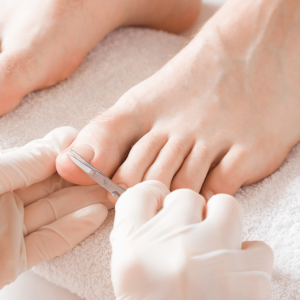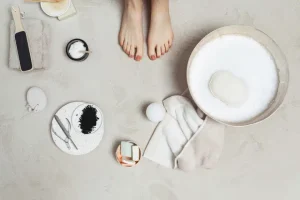
Costa Tropical Internet
Just another WordPress site
Pedicures, while a popular and often indulgent grooming activity, may pose several health risks, particularly during the summer months. The warm weather calls for open-toed shoes and sandals, prompting many individuals to seek professional pedicure services for aesthetically pleasing feet. However, this routine practice is not without potential hazards. Unsanitary salon conditions, improperly sterilized tools, and inexperienced technicians can lead to infections, nail deformities, and even serious diseases such as hepatitis and MRSA, a type of staph infection resistant to many antibiotics.
The summer season exacerbates these risks due to the increased humidity and heat, creating an ideal environment for bacteria and fungi to thrive. Furthermore, exposure to sunlight after a pedicure can increase the risk of skin cancer if the foot has been treated with certain chemicals, like those found in some nail polishes. Additionally, shared footbaths, often used in salons, are a breeding ground for bacteria and fungus, especially when not cleaned properly between clients. If a client has an open cut or sore on their foot, this can lead to an increased risk of infection.
Moreover, the common practice of cutting cuticles during a pedicure can also pose a significant health risk. The cuticle acts as a barrier against bacteria and fungi, protecting the nail and the skin beneath it. When this protective layer is cut or pushed back, it leaves the nail susceptible to infections. Another common issue that arises from pedicures is toenail fungus, a condition where the nail becomes discolored, thickened, and brittle. This is most often caused by the tools used during the procedure not being adequately sterilized.
In addition to the aforementioned risks, certain populations may be more susceptible to complications from pedicures. Individuals with diabetes, poor circulation, or weakened immune systems are at a higher risk of developing infections from minor nicks or cuts that can occur during a pedicure. These individuals should exercise caution and consult with their healthcare provider before undergoing a professional pedicure.

While these potential risks may seem daunting, they should not deter individuals from getting pedicures entirely. Instead, they should serve as a reminder of the importance of practicing safe and hygienic grooming habits. It’s crucial to choose a reputable salon that follows stringent hygiene practices, including using sterilized tools for each client and thoroughly cleaning footbaths after each use. Clients should also avoid having their cuticles cut and limit their exposure to harmful chemicals by choosing non-toxic nail polishes.
In conclusion, pedicures, particularly during the summer months, can pose several health risks if not done in a sanitary and professional manner. It’s essential to be aware of these potential hazards and take necessary precautions to ensure a safe and enjoyable pedicure experience.
The correlation between the rise in summer heat, increased moisture levels, and heightened risk of fungal infections is a topic of considerable importance. As temperatures escalate during the summer months, so does the moisture content in the air, creating an ideal environment for the proliferation of fungi. This is due to the fact that fungi, which are a type of microorganism, thrive in warm, damp conditions. Consequently, the summer season, with its high temperatures and humidity, provides an optimal breeding ground for these organisms. Fungal infections, such as athlete’s foot, yeast infections, and jock itch, are more prevalent during this time because the fungi responsible for these conditions flourish in the moist, warm environments often found in shoes, clothing, and areas of the body that are prone to sweating.
Further, the increased use of air conditioners and fans during the hot summer months can potentially circulate fungal spores throughout living and working spaces, thereby increasing the risk of exposure to these infectious agents. It is also worth noting that individuals with weakened immune systems or certain underlying health conditions may be particularly susceptible to fungal infections during this season. Therefore, it is crucial to maintain personal hygiene, wear breathable fabrics, and keep living and working environments clean and dry to mitigate the risk of fungal infections during the summer. Understanding the link between summer heat, moisture, and the increased risk of fungal infections is key in preventing and effectively managing these conditions.
Pedicure products and practices, while generally considered safe and beneficial for the majority of people, can have detrimental effects on individuals with sensitive skin. The impact of these products and treatments can be significantly more severe for this group, leading to potential skin irritations and allergic reactions. The ingredients contained within many pedicure products can trigger an inflammatory response in sensitive skin types, causing redness, itchiness, and even pain.
Moreover, the practices employed during a pedicure can exacerbate these reactions. Scrubbing, filing, and the use of certain tools can damage the skin’s protective barrier, permitting allergens and irritants to penetrate more deeply and provoke inflammation. In addition, soaking feet in hot water can strip the skin of its natural oils, leading to dryness and irritation. The frequent use of nail polish and removers can also cause adverse reactions, as they often contain harsh chemicals like toluene and formaldehyde.
Even the environment in which a pedicure takes place can influence the skin’s response. For example, an unsanitary salon can expose clients to harmful bacteria and fungi, which can lead to infections, especially in individuals with compromised or sensitive skin.
Therefore, it is crucial for those with sensitive skin to approach pedicure products and practices with caution. This might involve researching products to ensure they do not contain potential irritants, or choosing salons that prioritize hygiene and utilize gentle techniques. It is also advisable to perform a patch test with new products before applying them fully.
In conclusion, while pedicures can provide an enjoyable and relaxing experience, they can also pose risks for individuals with sensitive skin. By being informed and cautious, these individuals can better protect their skin and still enjoy the benefits of a pedicure.

Foot injuries and infections can often arise from improper pedicure techniques, undermining foot health and causing significant discomfort. A major concern is the development of fungal infections, as fungi thrive in the damp, warm environments often created by foot spas, particularly when tools aren’t adequately cleaned or sterilized. Additionally, ingrown toenails are another common issue, typically resulting from incorrect nail trimming. Cutting the toenails too short or in a rounded fashion can cause them to grow into the surrounding skin, leading to inflammation and potential infection.
Another frequent problem is the transmission of plantar warts. They are caused by a type of HPV virus that can be easily spread in a spa setting. If the pedicure tools used have been in contact with a wart on someone else’s foot and are not properly disinfected, the virus can be transmitted to another client. Furthermore, improper use of foot files and pumice stones can lead to skin abrasions or even ulcers, especially in individuals with diabetes or poor circulation.
Pedicure-induced foot injuries and infections can also include bacterial infections such as staphylococcus aureus and pseudomonas aeruginosa. These can emerge if cuts or abrasions are created during the pedicure process and are then exposed to the bacteria, which can be present in foot spas or on improperly cleaned tools.
To avoid these problems, it is crucial to ensure that pedicure tools are correctly sterilized, foot spas are thoroughly cleaned, and proper techniques are used when performing the pedicure. It is also essential to recognize the signs of foot infections or injuries, such as redness, swelling, pain, or unusual changes in the skin or nails, and to seek medical attention if necessary. By prioritizing foot health and safety, individuals can enjoy a pampering pedicure experience without compromising their wellbeing.
Shared spaces like public nail salons can pose significant hygiene concerns due to the risk of infection transmission. Shared equipment such as nail files, cuticle pushers, and nail clippers, if not properly sanitized, can become vectors for various bacteria, fungi, and viruses. In particular, staphylococcus, a common bacteria found on the skin, can cause serious infections if it enters the body through a cut or break in the skin. Furthermore, fungal infections like athlete’s foot and ringworm are highly contagious and can easily spread in a salon environment. Viruses like hepatitis and HIV, although less likely, can also potentially be transmitted if the salon does not observe strict sterilization protocols.
Even foot spas, which are meant to be relaxing, can harbor mycobacteria leading to infections in the legs. These risks are compounded when salons use poor quality products or do not adhere to industry best practices for cleanliness and sanitation. For instance, using tools directly from a package without sterilizing or reusing disposable items can increase the chances of infection. It is therefore crucial for customers to ensure they choose reputable salons that prioritize hygiene and safety. Some ways to identify such salons include checking for visible cleanliness, inquiring about their sterilization methods, and observing whether staff wear gloves during procedures. It is also advisable to bring your own tools to the salon to further minimize risk. In conclusion, while nail salons offer a convenient service, they also carry certain hygiene risks due to shared equipment. By being proactive and cautious, customers can mitigate these risks and enjoy a safer salon experience.

When it comes to enjoying pedicure treatments, it is crucial to prioritize your health and safety to prevent possible infections or injuries. Understanding the preventative measures that you should take can significantly minimize potential health risks. One of the fundamental steps is to ensure that the salon maintains high cleanliness and hygiene standards. The instruments used must be appropriately sterilized between clients, and the footbaths should be disinfected after each use. If the salon does not follow these practices, it could be a breeding ground for bacteria and fungi, which can lead to infections. Another tip is to avoid shaving your legs before a pedicure. Small cuts or nicks can allow bacteria to enter your body. Additionally, keep an eye on the products that are being used. They should be of high quality, and the technician should not use any product that has an expired date.
Inspect the condition of your feet and nails before your appointment. If you notice any signs of fungal infection, such as discolored or thickened nails, postpone your pedicure until you have had the issue treated. It’s also wise to bring your own tools to the salon. This way, you can be sure that they are clean and sterilized, reducing the risk of infection. If you have diabetes or any other condition that affects your foot health, speak to your healthcare provider before getting a pedicure to ensure it’s safe for you to do so. Finally, if at any point during your pedicure you experience discomfort or pain, let your technician know immediately. Pedicures should be a relaxing and enjoyable experience, not a painful one. By following these preventative measures, you can ensure your pedicure experience is not only relaxing but also safe.